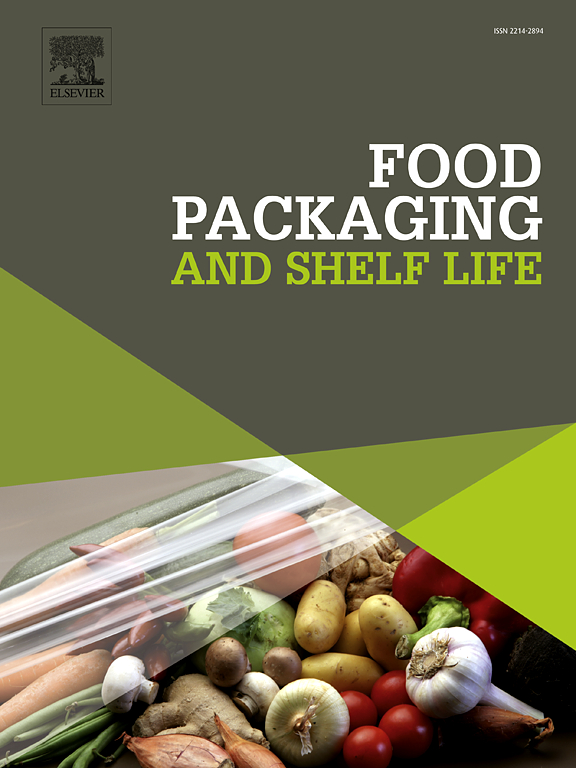富含(E)-肉桂醛提取物注入醋酸纤维素基活性包装膜对精选新鲜果蔬的实际功效
IF 10.6
1区 农林科学
Q1 FOOD SCIENCE & TECHNOLOGY
引用次数: 0
摘要
本研究旨在探讨醋酸纤维素基活性包装膜在鲜切果蔬常温保鲜中的实际应用。共有六种不同的鲜切样品被选中,分别是“富士”苹果、“马斯”香蕉、中国芹菜、卷心莴苣、绿豆芽和土豆。肉桂树皮中富集的(E)-肉桂醛提取物是活性包装中抑制酶促褐变和真菌生长的有效成分。活性包装对低酚含量(11.53 ± 1.33-31.66 ± 2.13 mg GAE/100 g FW)的鲜切样品(如芹菜、卷叶莴苣和绿豆芽)具有3-5 天的防褐变效果。潜在的观察结果表明,(E)-肉桂醛作为竞争性PPO抑制剂,其作用可能受到高浓度酚类底物的影响。同时,活性包装对所有鲜切样品的酵母和霉菌生长均有抑制作用,抑制时间为一周。从所选鲜切样品中分离出的腐坏酵母菌和霉菌为曲霉、念珠菌、隐球菌和镰刀菌。通过延缓低酚类样品褐变和抑制真菌生长,证实了醋酸纤维素活性包装对果蔬保鲜的有效性。除了减少食物浪费、提高食品安全和促进可持续消费之外,这种活性包装已经达到了5级技术成熟度,可以在超市和供应商的货架上展示。本文章由计算机程序翻译,如有差异,请以英文原文为准。
Real world efficacy of enriched (E)-cinnamaldehyde extract-infused cellulose acetate-based active packaging film on selected fresh-cut fruits and vegetables
This study aimed to explore the real-world application of cellulose acetate-based active packaging film on fresh-cut fruits and vegetables preservation at room temperature. A total of six different fresh-cut samples were selected, namely ‘Fuji’ apple, ‘Mas’ banana, China celery, Iceberg lettuce, mung bean sprout and potato. The enriched (E)-cinnamaldehyde extract from cinnamon bark was the active ingredient incorporated into the active packaging to inhibit enzymatic browning and fungal growth. The active packaging demonstrated effectiveness in preventing browning of fresh-cut samples with low phenolic content (11.53 ± 1.33–31.66 ± 2.13 mg GAE/100 g FW), such as China celery, Iceberg lettuce and mung bean sprout for 3–5 days. The underlying observation revealed that (E)-cinnamaldehyde acted as a competitive PPO inhibitor, where its effect can be compromised by the presence of high concentration of phenolic substrates. In the meantime, the active packaging was effective to inhibit yeast and mold growth of all the fresh-cut samples by a week. Aspergillus spp., Candida spp., Cryptococcus spp., and Fusarium spp. were identified as the spoilage yeast and mold isolated from the selected fresh-cut samples. The validation of the cellulose acetate-based active packaging on fresh-cut fruits and vegetable preservation was corroborated by delaying the browning of low phenolic content samples and inhibiting fungal growth. In addition to reducing food waste, enhancing food safety and promoting sustainable consumption, the active packaging has achieved Technology Readiness Level 5, making it ready for demonstration on supermarket and vendor shelves.
求助全文
通过发布文献求助,成功后即可免费获取论文全文。
去求助
来源期刊

Food Packaging and Shelf Life
Agricultural and Biological Sciences-Food Science
CiteScore
14.00
自引率
8.80%
发文量
214
审稿时长
70 days
期刊介绍:
Food packaging is crucial for preserving food integrity throughout the distribution chain. It safeguards against contamination by physical, chemical, and biological agents, ensuring the safety and quality of processed foods. The evolution of novel food packaging, including modified atmosphere and active packaging, has extended shelf life, enhancing convenience for consumers. Shelf life, the duration a perishable item remains suitable for sale, use, or consumption, is intricately linked with food packaging, emphasizing its role in maintaining product quality and safety.
 求助内容:
求助内容: 应助结果提醒方式:
应助结果提醒方式:


